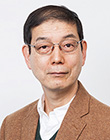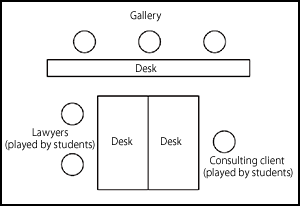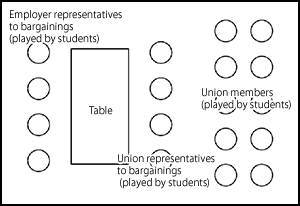Top>Education>Scenes from Law School and Business School
 Index
Index

Shinichiro Toyama [profile]
Scenes from Law School and Business School
Shinichiro Toyama
Member of Dai-Ichi Tokyo Bar Association
Professor, Graduate School of Law, Chuo University
Areas of Specialization: Corporation Compliance, Modern Contract Law, Illegal Action Compensation Law (traffic accidents, medical accidents, nuclear accidents, etc.), Domestic Relations Case Procedure Act, Labor Law, Insolvency Proceeding Law, Financial Legal Affairs, Antitrust Act, Personal Information Protection Law, Alternative Dispute Resolution (ADR), Legal Economics
1 Two professional graduate schools
This year marks the twelfth anniversary of the Law School System which was implemented in Japan in 2004.
I teach four courses at the Chuo Law School. The first is Life Disputes and Law, a course in legal fundamentals for first-year students. The remaining three—Mock Court (Civil Trial), Externship, and Legal Clinic—are courses in practical fundamentals and are taken by second/third-year students.
Among these courses, Legal Clinic is a special practical cut course of the Chuo Law School. The course is intended as a bridge between theoretical education and practical education. As chairperson of the Legal Clinic Committee, I am responsible for management activities such as designing the course curriculum and conducting PR activities.
The syllabus for the 2015 academic year lists clinic classes based on the following ten themes.
| 1) Fundamentals of Administrative Law |
| 2) Civic Life Disputes |
| 3) Alternative Dispute Resolution (ADR) |
| 4) Domestic Relations Case Procedure Act |
| 5) Public Criminal Defense |
| 6) Bankruptcy & Corporate Revitalization |
| 7) Corporate Law |
| 8) Fundamentals of Intellectual Asset Law |
| 9) Individual Labor Disputes |
| 10) Practice of International Human Rights Law |
Among these themes, I teach classes in 3) Alternative Dispute Resolution (ADR) and 9) Individual Labor Disputes.
Furthermore, from 2011, I started to teach the shared fundamental course Modern Contract Law at the Chuo Business School. As a result, my classroom scenes as a professor have expanded even further.
The Chuo Business School (MBA Program) is a professional graduate school which cultivates leaders in strategic management by targeting only working professionals.
The Chuo Business School curriculum combines aspects of strategy, marketing, human resources management, finance, and management legal affairs. Working students acquire their MBA (Masters of Business Administration: Professional) in two years by studying at the downtown Korakuen Campus on weekday nights and weekends.
I teach classes on weekday nights from 6:30 p.m. to 9:40 p.m. Students at the business school arrive out of breath after hurrying to the classroom from their offices. I always remember the traditional of night school at Chuo University and am deeply impressed by the motivation of working students to learn.
Incidentally, it is said that night school classes at New York University are more fast-paced and interesting than day school classes. This is because night school students include many businesspeople who are working hard on Wall Street.
2 Scenes from classes at Chuo Law School: Legal Clinic (Individual Labor Disputes)
Based on a course packet which is perhaps a bit too elaborate design, classes feature a variety of practical and role-playing activities including labor lawyering (mock labor consultation), fieldwork (labor committees, labor law firms, etc.) and mock labor courts.
I would now like to give a brief introduction for classes in labor lawyering.

(1) Formation of units
A standard unit consists of one student playing the role of consulting client and two students acting as lawyers. Graduate students not involved in the unit take part in the gallery.
(2) Establishment of consultation space
Consultation space is established in the classroom. The unit and gallery are positioned as shown in the diagram below.
(3) Roleplaying of the consulting client
The student acting as the consulting client selects a theme from example analysis drills (class material which I personally create) and then consults with the students acting as lawyers. The consulting client is free to use their imagination to flesh out their story and background, to the extent that there is no contradiction with the story for the selected theme. This process is known as story-making.
(4) Roleplaying of the lawyers
① Thirty minutes are given for consultation time. Students acting as lawyers are free to refer to available material other than the example analysis drills.
② Lawyers listen carefully to the details of the consultation, confirm facts and accurately assess the needs of the consulting client. Based on this understanding, they determine the applicable legal standards and extract important facts to be a statutory requirement. Finally, they formulate a solution to meet the consultation needs and give an easy-to-understand explanation (presentation) to the client.
③ If confusion arises during the consultation, the two lawyers can take an appropriate amount of time to discuss matters between themselves or to refer to available material.
(5) Participation by gallery
Gallery members review the method and content of the roleplaying consultation which they observed. Specifically, they give presentations which simulate how they would elicit facts, conduct legal analysis of said facts, and formulate solutions if they were the lawyers handling the consultation.
(6) Impression from law school students
“I was able to form a specific image of how the legal knowledge I am studying now can be applied in the near future.” “The legal material which I learned came to life before my eyes.”—From comments such as these, it seems that the Legal Clinic is quite useful in improving the learning of law school students.
3 Scenes from classes in modern contract law: Chuo Business School
Classes are designed based on the following three core elements.
- Ⅰ.Fundamental knowledge of contract law theory
- Ⅱ.Legal resolution of contract disputes
- Ⅲ.System for analyzing and preventing contract dispute risk
Based on these elements, classes are formulated through the unique utilization of various class method kits (lectures, group discussion, presentation, video viewing, writing and roleplaying).
Roleplaying of collective bargainingsings was conducted in classes during M3 of 2014 (the Chuo Business School uses academic quarters, dividing one year into four quarters of M1 to M4).

① Twelve business school students (all working professionals) were divided into four students who played the role of employer representatives to bargainings and eight students who acted as members of a community labor union. Of those eight students, four students were cast as labor union representatives to the bargainings.
② A real case of worker layoffs was used as the theme for roleplaying of collective bargainings. Everyone involved in the role-play was free to create a story, as long as there were not contradictions with case facts as listed in the distributed materials. A space for collective bargainings was established as shown in the diagram below.
Compared to law school students, business school students have obtained more experience in society through their careers. As a result, a great deal of imagination was exercised during the role-play. Classes had the feeling of authentic bargainings and were extremely realistic.
These classes served as a bridge between legal theory and practice for business school students who have accumulated diverse professional and social experience. Rather than devolving into vain speculation, classes were true to the actual interest of bargaining parties and stayed grounded in reality. I was very impressed.
My experience in teaching these classes led to the strong affirmation that laws are the support system which makes good business possible. I also realized that legal education for the youth, law school education for cultivating legal professionals, and education for working professionals which bridges between legal theory and practice are essential to promote and support a healthy legal society in Japan.
4 Helping people and shaping people
The work of a lawyer can be described as helping people; specifically, based on facts in the client’s past, lawyers fully utilize their legal skills to provide assistance in resolving problems or disputes. On the other hand, the work of a teacher can be described as shaping people; as teachers assist students in creating their own future through learning.
Both professions are fulfilling and future-oriented. I sometimes feel that I was born to do such work. Every day, I engage in my work with a passionate heart and a rational mind.
[Reference Literature]
(1) Class reports published in the Chuo Law Journal (Chuo University Press)
- ◯Legal Clinic (ADR) : the second semester 2004
Vol. 2, Issue No. 1, from p. 137 - ◯Issues and Current Conditions of Externships
Vol. 2, Issue No. 3, from p. 105 - ◯Role-Playing Methods in Practice
Vol. 3, Issue No. 1, from p. 109 - ◯Legal Disputes in Daily Life : Legal Practice Image Training Method
Vol. 4, Issue No. 4, from p. 67 - ◯Daily Disputes in Crisminal Court! "Saibanin" System Workshop
Vol. 5, Issue No. 3, from p. 101 - ◯Legal Disputes in Every Life : Civil Law Workshop
Vol. 6, Issue No. 3, from p. 125 - ◯Legal Clinic (Individual Labor Disputes): Labor Tribunal Role-Playing
Vol. 7, Issue No. 1, from p. 101 - ◯A Comper dium of Alternative Dispute Resolution Methods
Vol. 7, Issue No. 3, from p. 79 - ◯Field Work of Tokyo Labor Relations Commission
Vol. 8, Issue No. 3, from p. 161
(2) Educating Lawyers: Preparation for the Profession of Law
Written by William M. Sullivan et. al., translated by Noboru Kashiwagi et. al.
Translation series (No. 64) by the Institute of Comparative Law in Japan (Chuo University Press)
(3) Educational Methods at Law Schools
Japan Law Foundation (Commercial Legal Work)
The Two Basic Laws of Life: Family Law and Labor Law (Opinion article published for Chuo Online on March 18, 2013)
https://www.yomiuri.co.jp/adv/chuo/opinion/20130318.html
- Shinichiro Toyama
Member of Dai-Ichi Tokyo Bar Association
Professor, Graduate School of Law, Chuo University
Areas of Specialization: Corporation Compliance, Modern Contract Law, Illegal Action Compensation Law (traffic accidents, medical accidents, nuclear accidents, etc.), Domestic Relations Case Procedure Act, Labor Law, Insolvency Proceeding Law, Financial Legal Affairs, Antitrust Act, Personal Information Protection Law, Alternative Dispute Resolution (ADR), Legal Economics - Shinichiro Toyama was born in 1951. After graduating from the Faculty of Law, Chuo University in 1975, he acquired a law license (the management of Yamashita and Toyama Law and Patent Office). He became a Specially-Appointed Professor at Chuo Law School from 2004. He has served as Professor at Chuo Law School from 2014 to the present. His major public positions include serving on the Nuclear Damage Compensation Judging Special Committee of the Ministry of Education, Culture, Sports, Science and Technology; serving on the Adjustment of Construction Work Disputes Central Committee of the Ministry of Land, Infrastructure and Transport; serving as an outside expert for Inspection Department of Minister’s Secretariat of the Ministry of Agriculture, Forestry and Fisheries, serving as a member of the Civil Conciliation Council (Musashino Summary Court), serving on the Hachioji-shi Information Disclosure and Personal Information Protection Management Council, serving as a director of the Nichibenren Traffic Accident Consultation Center, and serving as a medical ADR arbitrator for the Tokyo San-Bengoshikai. The author’s main publications include “Antimonopoly Law Useful for Daily Living,” “The World of Traffic Accident Civil Liability: Theory and Practice,” “Future of Law Practice: Gradual Evolution Theory of Conflict Resolution by Lawyers,” “Resolution of Individual Labor Disputes: Act on Labor Inquiry and Labor Contact Act,” “Child Welfare and Joint Custody,” and “JA Compliance: Creating a System for Preventing Misconduct.” This article is edited and expanded version of a short essay published in the June 2013 edition of the journal “Freedom and Justice” (Federation of Japanese Bar Associations).
- Research Activities as a Member of Research Fellowship for Young Scientists (DC1), Japan Society for the Promotion of Science (JSPS) Shuma Tsurumi
- Important Factors for Innovation in Payment Services Nobuhiko Sugiura
- Beyond the Concepts of Fellow Citizens and Foreigners— To Achieve SDGs Goal 10 “Reduce Inequality Within and Among Countries” Rika Lee
- Diary of Struggles in Cambodia Fumie Fukuoka
- How Can We Measure Learning Ability?
—Analysis of a Competency Self-Assessment Questionnaire— Yu Saito / Yoko Neha - The Making of the Movie Kirakira Megane








